16 Healthy and Edible Indoor Plants
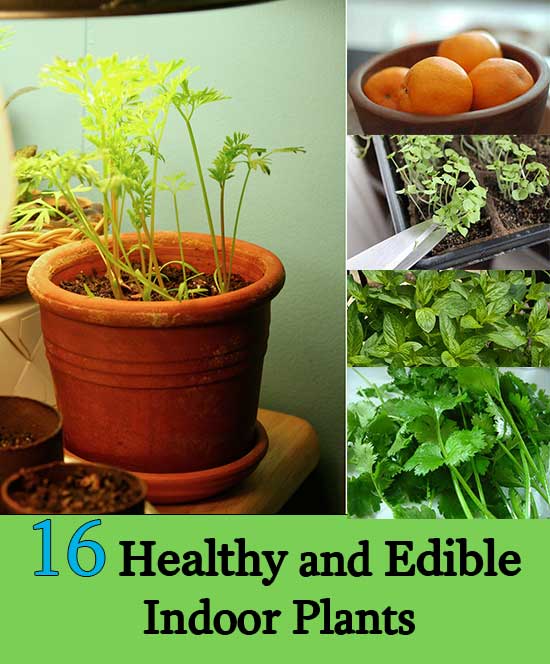
More and more people are embracing farm-fresh and homegrown produce. The reasons for this are extensive, and include environmental friendliness, saving money, and enjoying better quality of products than those available in modern megastores. By growing food at home, many people also can take heart in knowing exactly where their food originates and what chemicals and processes went into making it.
If you have a few sunny windows and a little time, it turns out your capable of growing some very healthy and tasty crops in the comfort of your own home. Following is a guide to 16 easy and healthy plants you can grow indoors to improve the quality of your family’s diet.
Before you start planting and potting, though, here are a few tips to keep in mind no matter which of the following plants you choose to grow:
- All of the following plants require adequate drainage, so either use a pot with holes in the bottom or pile up some stones in the bottom of your pot before adding soil. If you choose to use a pot with holes, be sure to put a shallow container under the pot to prevent drainage onto your floor or windowsill.
- For each plant, you can start with a general potting mix available from a local garden center or experiment with your own. Each plant grows in slightly different conditions, so be mindful of your individual plant requirements when choosing a soil.
- Many of the plants featured grow best in areas that receive lots of direct sunlight and remain warm throughout the day. Sunny windows are the best way to assure adequate growing, but if you don’t have much available you can also use indoor growing lights as they help maintain optimum light and temperature conditions for plants regardless of surrounding conditions.
Fruits and Vegetables
1. Avocados
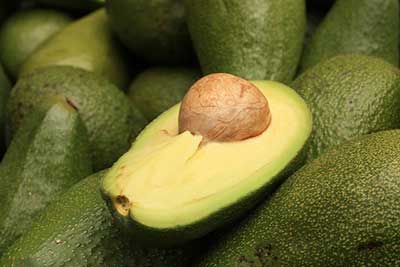
Jam-packed with healthy fats, vitamins E, B6, and A, Avocados have been shown to reduce the risk of such diseases as cancer, heart disease, and eye degeneration.
For best results, start with a dwarf avocado plant. Put some sand in the bottom of a large, well-draining pot before topping it with potting mix and planting the tree. Water regularly but keep the soil from getting overly soggy as avocado roots are sensitive to over watering. Prune the tree’s shoots regularly and make sure to have adequate space available for growth as even dwarf avocado trees can grow up to around 10 feet tall.
Green varieties of avocados are ready to harvest when the skin of the fruits turns slightly yellow. Darker varieties of avocados are ready to pick when the skins turn dark and nearly black. Ripe fruits can be left on the tree for a few weeks until ready to use, but over-ripening will lead to loss of flavor and texture.
2. Carrots

Carrots are a great source of vitamins and minerals like thiamin, niacin, folate, potassium, manganese, and vitamins B6, A, C, and K. Carrots are also rich in carotenoids which are beneficial to healthy eyesight.
To start, plant carrot seeds in a pot that is at least 18 inches in depth and width. Fill the pot with an inch from the top with a humus-rich soil mix. Water the soil then plant the seeds by pressing gently into the soil and covering them an inch apart from each other and in rows that are spaced at least six inches. Keep the soil moist, but not soaked, and make sure the container gets plenty of light. Sprouting occurs in approximately two weeks.
Harvest time for carrots is when they’ve grown to about ¾ of an inch in diameter at the base of the stem. If you’re having trouble seeing the carrots, you can size them by simply brushing the soil away from the stem. Keep in mind that when overgrown, carrots will start to lose their flavor and sweetness, so harvest appropriately. To pick the carrots, grab them firmly by the stem and wiggle them until you can pluck them straight up. Immediately after harvest, remove the greens, wash off excess dirt, and let dry before storing in the refrigerator.
3. Garlic Greens
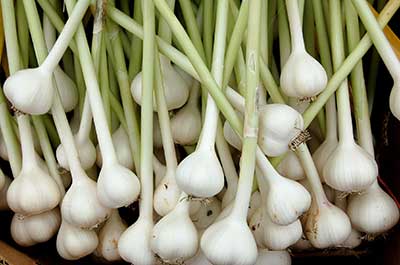
Garlic is a member of the cancer-fighting allium family of vegetables. Garlic is also linked to improvements in blood pressure, heart disease, and high cholesterol. While growing garlic bulbs indoors is rather difficult, garlic greens have all the same health benefits and can be used in recipes as you would scallions.
To get started, plant garlic bulbs with small cloves in a 4-inch pot with drainage holes or a simple quart-sized yogurt or cottage cheese container with holes in the bottom. Fill the pot with soil to about a half an inch of the top. Break the bulbs into individual cloves and, with the peel intact, push the cloves about an inch into the soil with the pointy end up. You can plant about 12 cloves close together and water regularly making sure the soil stays moist but not soggy. Green shoots should pop up within a week or so if left in a sunny spot.
Once the garlic greens are 8-10 inches tall, just trim off the quantities you need with scissors. Each clove will only provide one harvest of good greens, so when the cloves start putting up fresh sprouts, you will need to keep replanting to maintain a constant supply.
4. Lemons
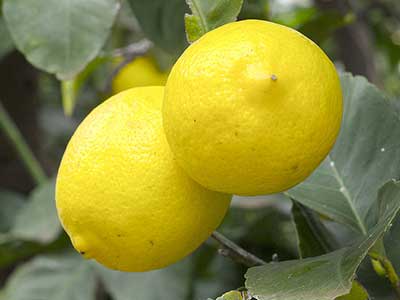
Lemons are very rich in vitamin C and antioxidants, in addition to being a natural anti-inflammatory. Lemons are shown to decrease the risk of heart disease and fight some cancers.
If you are interested in having fruit to harvest right way, start with a 2-3 year-old dwarf tree from a nursery. Select a pot slightly larger than the root ball of your tree. Fill the drainage dish of your pot with stones to allow air to circulate and be sure to use a potting soil specifically made for citrus trees. Place the plant in an area that will get 8-12 hours of light each day and will maintain a temperature between 55-85 degrees Fahrenheit. Keep soil moist but not overly wet. Citrus plants respond well to moist air, so misting the leaves regularly will help the plant stay perky.
Most lemons will ripen in 6-9 months. Full yellow color and a slight give to a gently squeezed lemon rind will indicate ripeness.
5. Mandarin Oranges
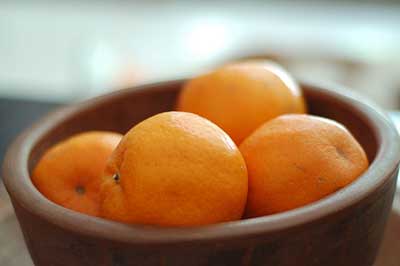
Sweet and useful in a lot of various recipes, mandarin oranges are a good source of natural antioxidants, calcium, phosphorous, magnesium, and fiber.
For best results, start with dwarf mandarin orange trees. The trees will grow best in large pots, rich soil, and sunny locations. Light should be regulated by regular turning, and the soil should be watered regularly, but allowed to dry slightly before adding more. These trees can grow up to six feet tall and have very aggressive roots. If the roots of your plant begin to grow back on themselves or through the drainage holes in your pot, transfer the plant to a container at least 2 inches larger in diameter.
Mandarin oranges need to be harvested as soon as they turn orange for flavor preservation. Simply clip or carefully twist and pull the fruit from the tree, taking care to keep the “button” of the orange remains intact.
6. Microgreens
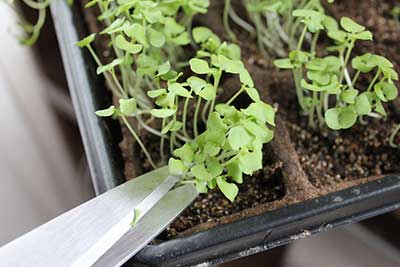
Essentially the seedlings of various herbs and vegetables, microgreens are believed to have even more nutrients than full-grown plants and are a great source of vitamins A, C, K, and folate.
Begin with a variety of seeds, such as radishes, kale, Swiss chard, beets, basil, and dill. Fill a shallow seedling tray or shallow pot to the top with potting mix. Moisten the soil then sprinkle the seeds over the top so they are close but not touching each other. Then cover the seeds with a thin layer of soil. Keep in a sunny area and mist or lightly water the soil so that it remains moist. In less than a week, the seeds should begin to sprout and will then require a constant temperature of 60-70 degrees and approximately 12-14 hours of light per day. Keep the roots moist, but avoid soaking the greens which can cause wilting.
Once the seedlings have grown to 1-2 inches tall, they’re ready to eat! Hold the stem of the greens and use a pair of scissors to cut off the leaves, making sure not to damage the roots. Left intact, multiple harvests can be taken from the same crop. Microgreens can be eaten immediately or refrigerated in a plastic bag for up to 5 days.
7. Mushrooms
More than just being tasty, mushrooms are also a good source of fiber and vitamin C as well as antioxidants and cancer-fighting elements.
The best and easiest way to grow your own mushrooms is in a laundry basket or with a purchased kit. Those kits are relatively cheap and available online.

8. Salad Greens
As with microgreens, salad greens like iceberg, spinach, romaine, red leaf, and arugula are jam-packed with vitamins A, C, and K, and also folate and iron.
To grow salad greens, start with seeds or starter plants from a local nursery. Choose a well-draining planter box and fill it with potting soil. Then poke holes into the soil with your finger approximately 4 inches apart.
If using seeds: Sprinkle a few seeds into each hole, then pat the soil to cover them.
If using starter plants: Use your hands to loosen the roots of each plant before placing in a hole then fill in around them with potting soil.
After planting: Water the soil. If growing from seed, pull all but the largest and healthiest shoots. Keep the soil moist to the touch.
Salad greens will produce multiple crops, so to harvest, pull only the outer leaves and try not to harm the roots or interfere with the plant’s ability to keep growing.
9. Scallions
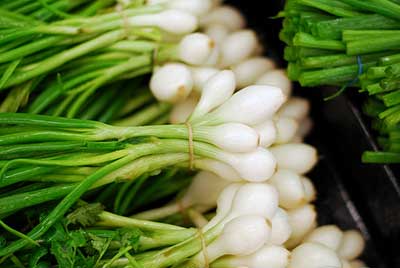
As with garlic, scallions are part of the allium family, associated with cancer prevention and protecting against cellular damage.
To grow at home, simply buy a bunch of scallions, and with a rubber band, wrap the bulbs together and place the bundle in a glass with about an inch of water in the bottom. When new green shoots appear and the roots have grown to about double their length, plant the scallions in a shallow pot and keep in full sun. Keep soil from drying excessively between watering.
To harvest scallions, snip the greens off, leaving about an inch or two of the plant in the dirt. To utilize the bulbs of the scallion, harvest the clump when the greens are about six inches tall. Properly cleaned and trimmed, scallions can last in the fridge for a week, particularly if wrapped in a moist paper towel before bagging.
10. Tomatoes
Tomatoes are a natural source of lycopene, which has antioxidant and anti-inflammatory properties and may also help prevent coronary heart disease.
For a single plant, start with a six-inch pot or use a larger pot if you’d like to grow two plants. For a continuous supply of fresh tomatoes, start one or two new plants from seed approximately every two weeks. Fill your selected pot with starter potting mix and plant seeds about a quarter of an inch deep. Keep the soil moist but not soggy and be sure to place in an area that receives plenty of sunlight. Rotating plants will insure that all sides grow evenly. Seeds sprout in 5-10 days and need to be transplanted to potting soil once the seedlings are about three inches tall. About two weeks after transplanting, add some organic fertilizer to the mix and keep watered so the soil is moist but not soggy. As the plants grow, they may need to be staked to minimize breakage of the stems. Once the plants bloom, it’s advisable to tap the main stem and larger branches gently with your finger to promote pollination.
Indoor tomatoes will not likely grow as large as their outdoor counterparts, but they will still have plenty of great tomato taste. When the fruits are red and firm with a slight give, they are ready for use. Either clip or gently twist and pull the fruits from their stems.
Herbs
11. Basil

Not only is basil flavorful, it is also believed to have natural anti-inflammatory properties.
To grow, start with seeds or a starter plant available at a nursery, grocery store, or online. Choose a container at least four inches wide. Basil requires warm temperatures and at least 6 hours of direct sunlight per day. It’s recommended to fertilize the soil in your basil pot about once a month with organic or slow-release fertilizer. Plants should be watered about once a day in hot conditions, or every other day otherwise. Pruning your plants will help you maximize your yield. When the top leaves of your plant reach about 6 inches tall, prune the plant to encourage it to fill out and be sure to remove any blossoms that appear.
To harvest simply snip a few leaves from each plant making sure to leave plenty of the plant to continue growing.
12. Chives
An excellent source of antioxidants, chives also store vitamins A & C.
To grow chives, fill a 6-8 inch pot nearly to the top with potting mix. Plant the seeds and cover them with a light layer of soil. Keep the container in an area that’s partially shaded and water regularly to make sure the soil never dries out.
To harvest your chives, again gently snip a few leaves from each plant, allowing the plants to continue growing.
13. Cilantro
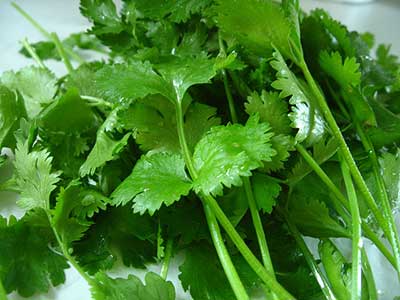
Cilantro contains high concentrations of carotenoids, a good source of vitamin A which may help protect against heart disease, stroke, and certain cancers.
In seed form, cilantro is better known as coriander, and it can also be purchased in starter plant form. Plant in a container that is at least 8 inches deep and fill the container to within 1-2 inches of the top with soil. Press the seeds down into the soil and water until moist. For best results, cover the seed pot with plastic wrap and secure with a rubber band until seedlings have germinated and grown to the level of the plastic. Keep the seedlings well-watered and make sure they receive plenty of light.
To harvest your fresh cilantro, gently remove a few leaves from each plant, and be sure not to remove all the leaves from any single plant.
14. Ginger
Known for its ability to ease nausea and motion sickness, there is also evidence that raw ginger can reduce inflammation of sore muscles, arthritis, and possibly even slow the growth of cancer cells.
Ginger is very easy to plant at home. Simply buy a chunk of ginger from your local grocer and cover it with soil in a pot, keeping the freshest-looking buds near the top. Keep the soil moist and provide indirect sunlight and then just wait for new growth to come up from the soil.
To harvest your ginger, pull the plant completely out of the soil, cut off the portion desired, and replant the ginger as above.
15. Mint

More than just a flavorful herb, fresh mint is known to ease digestion and, in tea form, soothe hangovers.
A sprawling plant, mint seeds or starter plants need a large deep pot about 10 inches in diameter. Fill the container with soil and plant the seeds or plants. Keep the soil moist and the planter in an area that gets plenty of sunlight.
To harvest fresh mint, snip a few leaves off of plants as needed but make sure not to take all the leaves off of any single plant.
16. Rosemary
Fragrant and herbaceous, fresh rosemary is a powerful antioxidant that may help control weight and cholesterol levels.
To grow rosemary, you can start from seeds or cuttings. The recommended soil is a mix of two parts potting soil to one part sand. To make the soil more basic, add a teaspoon of agricultural lime per five inches of pot diameter. Keep the container in a sunny area with at least six hours of sun per day and only water when the top of the soil is dry to the touch.
To harvest, snip a few sprigs from each plant but again, keep the plants producing fresh herbs for months to come!
 Home and Gardening Ideas At home and Gardening ideas we believe inspiring readers about homesteading, self sufficiency
Home and Gardening Ideas At home and Gardening ideas we believe inspiring readers about homesteading, self sufficiency






One comment
Pingback: 16 Healthy and Edible Indoor Plants